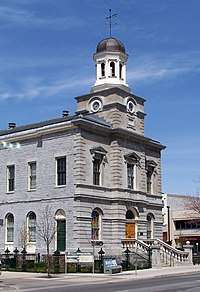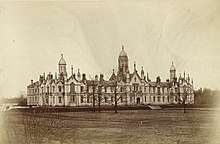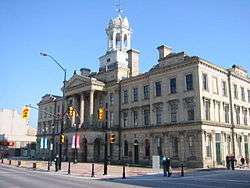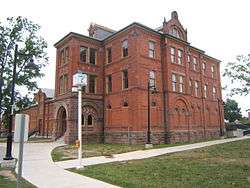Kivas Tully
Kivas Tully, ISO (1820 – 24 April 1905) was an Irish-Canadian architect.[1]
Kivas Tully | |
|---|---|
| Born | 1820 |
| Died | 24 April 1905 Toronto, Ontario |
| Nationality | Canadian |
| Alma mater | Royal Naval School |
| Occupation | Architect |
| Awards | Imperial Service Order. |
| Practice | John George Howard |
Life
Born in Garryvacum in County Laois, Ireland, Kivas Tully was the son of John P. Tully, a lieutenant in the Royal Navy, and Alicia Willington. He trained as an architect at the Royal Naval School in London, England, before coming to the Province of Canada in 1844, arriving in Toronto, where he began working at the firm of John George Howard, designing many important buildings throughout southern Ontario.
Following Canadian Confederation, Tully joined the Ontario Department of Public Works in 1868. He was appointed the first Ontario Provincial architect (1868–1896)[2] and engineer.[3] He was involved in the supervising of the competition leading to the design of the Ontario Legislative Building at Queen's Park. As the provincial department of public works' chief architect, Tully supervised a series of district courthouses built in northern Ontario. The courthouse at Parry Sound designed in 1871 still forms the core of the present courthouse complex.
The Ontario Archives hold drawings for virtually all provincial buildings including courthouses, registry offices, goals & lock-ups, schools and colleges, hospitals and other works executed under his supervision from 1896 until 1926.[4]
In 1903, Tully was awarded the Imperial Service Order. He had retired in 1896 and died in Toronto on 24 April 1905.
Works
Some of his more prominent projects include:
| Project | Year Completed | Location | Notes | Image |
|---|---|---|---|---|
| Bank of Montreal | 1846 | Northwest corner of Yonge Street and Front Street, Toronto | Neoclassical in style with quarters on the second and third floors for the manager and his family, the three-story stone building was demolished in 1886 for a new Beaux-Arts Bank of Montreal office which now houses the Hockey Hall of Fame.[5] | |
| St. Catharines Courthouse | 1850 | St. Catharines, Ontario | Neoclassical in finished and rough limestone, sympathetic limestone addition in 1865 |  |
| Old Trinity College | 1852 | Trinity Bellwoods Park, Toronto | Gothic Revival. Demolished in 1956. |  |
| Victoria Hall | 1860 | Cobourg, Ontario | Neoclassical |  |
| Welland County Courthouse | 1858 | Welland, Ontario | Designed in the Neoclassical style by Tully and constructed by John Hellems and William A. Bald of several courses of Queenston limestone. Addition added in 1954. | |
| First Trenton Town hall | 1860 | Trenton, Ontario | Neoclassical building was vacated by the police in the 1970s and now home to DBIA and Trent Port Historical Society Museum. |  |
| London Asylum for the Insane | 1870 | London, Ontario | Main building demolished 1870 and only Infirmary or Exam Building remains. Site vacant but part of London Psychiatric Hospital (Regional Mental Health Care) | |
| Parry Sound District Courthouse | 1871 | 89 James Street, Parry Sound, Ontario | Victorian court has had additions added 1920-1921 and still used as courthouse. | |
| Hamilton Asylum for the Insane | 1879 | Fennell Street West, Hamilton, Ontario | South cottage added 1885 and infirmary 1895; demolished 1990s; site now used by Centre for Mountain Health Services after transfer to St. Joseph's Healthcare-Hamilton | |
| Brockville Asylum for the Insane | 1892-1894 | Prescott Road, Brockville, Ontario | Main building and cottages, 1892–94; later renamed as Brockville Psychiatric Hospital and now Brockville Mental Health Centre | |
| Orilla Asylum for the Insane | 1886-1887 | Memorial Road cottages; Main Building (Victorian) added 1889; renamed as Huronia Regional Centre since 1974 | ||
| Mimico Branch Asylum | 1889–1895 | New Toronto, Toronto | Victorian psychiatric hospital campus with Romanesque Revival and Gothic Revival influences, restored and repurposed by Humber College from 1991–2001. |  |
Personal
Tully was married twice, first to Elizabeth Drew in 1844 (died 1847) and Maria Elizabeth Strickland in 1852 (died 1883). He had four daughters, and was survived by two, including the artist Sydney Strickland Tully (1860–1911), when he died in 1905.[6]
Publications
- Preliminary report of the engineer, on the survey of the various routes, for the proposed ship canal, to connect the waters of lakes Huron & Ontario at Toronto, presented to the president of the Board of Trade, 1857.
See also
Other Ontario provincial architects include:
- Francis R. Heakes
- George A. White
- George N. Williams
References
- Otto, Stephen A. (2009). "Tully, Kivas". Dictionary of Canadian Biography Online. XIII. Retrieved 6 December 2011.
- http://dictionaryofarchitectsincanada.org/appendix_a Dictionary of Architects in Canada
- Kristif, Andrea. "Kivas Tully". Canadian Encyclopedia. Retrieved 6 December 2011.
- http://dictionaryofarchitectsincanada.org/architects/view/1367
- Arthur, Eric (2003) [1986]. Toronto: No Mean City (3 ed.). Toronto: University of Toronto Press. p. 85.
- http://www.biographi.ca/009004-119.01-e.php?&id_nbr=7108
External links
| Wikimedia Commons has media related to Kivas Tully. |
- Works by or about Kivas Tully at Internet Archive
- Historic Places in Canada
- Kivas Tully Dictionary of Architects in Canada
| Political offices | ||
|---|---|---|
| Preceded by N/A |
Chief Provincial Architect, Ontario 1868–1896 |
Succeeded by Francis R. Heakes |